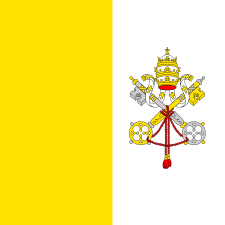Apostolic Penitentiary

 |
| Part of a series on the |
| Jurisprudence of Catholic canon law |
|---|
|
|
|
Trials and tribunals |
|
Canonical structures Particular churches
|
|
|
The Apostolic Penitentiary (Latin: Paenitentiaria Apostolica), formerly called the Supreme Tribunal of the Apostolic Penitentiary, is one of the three tribunals of the Roman Curia. The Apostolic Penitentiary is chiefly a tribunal of mercy, responsible for issues relating to the forgiveness of sins in the Catholic Church.
The Apostolic Penitentiary has jurisdiction only over matters in the internal forum. Its work falls mainly into these categories:
- the absolution of excommunications latæ sententiæ reserved to the Holy See,
- the dispensation of sacramental impediments reserved to the Holy See, and
- the issuance and governance of indulgences.
The head of the Apostolic Penitentiary, the Major Penitentiary, is one of the few Vatican officials who retain their positions sede vacante.[1] If the Major Penitentiary is a Cardinal Elector he is one of only three persons in the conclave allowed to communicate with those outside the conclave, so that he can continue to fulfill his duties (the other two being the Cardinal Vicar of Rome and the Vicar General for the Vatican City State).[2] The Major Penitentiary is a Titular Archbishop and is normally a Cardinal. Since 21 September 2013, the Major Penitentiary is Cardinal Mauro Piacenza. The second-highest-ranking official in the Apostolic Penitentiary, the Regent, is (since 26 June 2012) H.E.Msgr. Krzysztof Józef Nykiel.
When Pope Francis, with the Papal Bull Misericordiae Vultus (Latin: "The Face of Mercy") decreed that from the Solemnity of the Immaculate Conception of the Blessed Virgin Mary (a Holy Day of Obligation) on Tuesday, December 8, 2015, until the Solemnity of the Feast of Christ the King of the Universe on the last Sunday before Advent, in November 2016, the Church would observe a Special Jubilee Year of Mercy, he said he would let certain qualified priests (likely somewhat experienced ones, presumably with knowledge of canon law and confession) serve as "Missionaries of Mercy" to each Diocese, with the faculties to absolve even sins that are reserved to the Holy See through the Apostolic Penitentiary. Normally, a priest or even a bishop would not be able to do this unless the person was in danger of imminent death. The Pope has the power, as the earthly absolute sovereign of the Catholic Church, to make this special change for the year.[3][4][5][6]
Historical duties
Up until the 18th century, the Apostolic Penitentiary also considered cases of confessor-penitent disputes involving violations against what was termed the "external forum".
For particularly heinous sins (for example, rape or murder), or for serious sins committed by penitents of high political or cultural standing, it was often the practice to impose rather harsh penances. This practice was particularly true in the medieval Church, for sins referred to a bishop for absolution. If a penitent felt that the penance imposed was disproportionate to the sins committed, he could submit the dispute to the Apostolic Penitentiary. The alleged offense was said to be against the "external forum"; that is, related to public acts required of the penitent.
If the tribunal decided in favor of the penitent, they would issue a formal statement confirming that appropriate recompense had already been made, that the penitent's sins were forgiven, and that the matter was closed.
These statements were transcribed by legal clerks, who were paid by fees assessed by Apostolic Penitentiary for the transcription of their decisions. This practice prompted claims that the tribunal, and by extension the Church, accepted money for the forgiveness of sins.
Absolutions and dispensations
Normally confessions of sins are handled at the local level by priests and their bishops and are not heard by the tribunal. The work of the Apostolic Penitentiary involves sins, such as defiling the Eucharist, which are reserved to the Holy See. In late 2006, then Major Penitentiary Cardinal Stafford said this offense is occurring with more and more frequency, by ordinary faithful who receive Communion and then remove the host from their mouths and spit it out or otherwise desecrate it. Other sins that are handled by the Penitentiary include a priest breaking the seal of the confessional by revealing the nature of the sin and the person who sought penance, or a priest who has sex with someone and then offered forgiveness for the act. These sins bring automatic excommunication from the Church. Once the excommunication is lifted, then absolution can be granted. A fourth type of case that comes to the tribunal involves a man who has contributed towards facilitating an abortion, such as by paying for it, or directly so by performing one, who then seeks to become a priest or deacon.
Persons who wish to receive an absolution or dispensation reserved to the Holy See write a petition to the Penitentiary. Usually, this petition is written through their initial confessor. The petition must use pseudonyms when explaining the situation to avoid revealing the identity of the persons involved (which would violate the Seal of Confession), and the tribunal itself acts in complete secrecy. The Major Penitentiary considers the matter himself, unless it is particularly important, in which case the whole of the tribunal considers the petition. The members of the tribunal only give advice regarding the petition—the Major Penitentiary has the ultimate decision on whether the dispensation or absolution should be granted. If the Major Penitentiary is uncertain as to whether he has authority in a given case, he submits the matter to the Pope. The impediment or act in question must not be public, as it would then be a matter of the external forum and cannot be absolved or dispensed by the Penitentiary.
Indulgences
The Apostolic Penitentiary also specifies actions for which indulgences are granted, either permanently (in the Enchiridion Indulgentiarum,[7]) or on special occasions, such as the Year for Priests (19 June 2009 to 19 June 2010), during which a plenary indulgence is granted, on 19 June 2009, on first Thursdays, on 4 August 2009 (150th anniversary of the death of Saint Jean-Marie Vianney), and on 19 June 2010, to all the faithful who attend Mass, pray for priests to Jesus Christ the Eternal High Priest, offer any other good work they do that day, and satisfy the conditions for any plenary indulgence (detachment from all sins, the Sacrament of Penance within the last or next couple of weeks, holy communion (Eucharist in the Catholic Church), and praying for the Pope's intentions).[8] There are also adaptations for those unable to go to church, and daily indulgences available only to priests.
List of Major Penitentiaries
| Part of a series on |
| Penance and Reconciliation in the Catholic Church |
|---|
 |
|
|
1216–1405
- Nicola de Romanis (1216–1219)
- Tommaso da Capua (1219–1239)
- Bishop Guglielmo di Modena, O. Cart. (1244-1251)
- Hugh of Saint-Cher (ca.1256–1263)
- Gui Foucault (1263–1265)
- Henry of Susa (1266–1271)
- Pierre de Tarentaise (1273–1276)
- (1276–1279 – probably vacant)
- Bentivenga de Bentivengis (1279–1289)
- Matteo di Aquasparta (1289–1302)
- Gentile Partino (1302–1305)
- Berenger Fredoli (1306–1323)
- Gauscelin de Jean (ca.1327–1348)
- Etienne Aubert (1348–1352)
- Egidio Albornoz (1352–1367)
- Francesco degli Atti (substitute penitentiary c. 1353–1361)
- Guillaume Bragose (substitute penitentiary 1361–1367, grand penitentiary 1367)
- Galhardus de Boscoviridi (regent of the Apostolic Penitentiary 1367–1369)
- Etienne de Poissy (1369–1373)
- Jean du Cros (1373–1378[9])
- Giovanni d'Amelia (regent of the Apostolic Penitentiary 1378)
- Eleazario da Sabrano (1378–1379)
- Augustin de Lanzano (regent of the Apostolic Penitentiary 1379–1382)
- Luca Rodolfucci de Gentili (1382–1388)
- Augustin de Lanzano (regent of the Apostolic Penitentiary 1388–1389)
- Niccolo Caracciolo Moschino (1389)
- Francesco Carbone Tomacelli (1389–1405)
1405–1899
- Antonio Caetani (1405–1412)[10]
- Pierre Girard (1409–1415)[10]
- Giovanni Dominici (1408–1415[11])
- Giordano Orsini (1415–1438)
- Niccolo Albergati (1438–1443)
- Giuliano Cesarini (1444)
- Giovanni Berardi (1444–1449)
- Domenico Capranica (1449–1458)
- Filippo Calandrini (1459–1476)
- Giuliano della Rovere (1476–1503)
- Pedro Luis de Borja-Lanzol de Romaní (1503–1511)
- Leonardo Grosso della Rovere (1511–1520)
- Lorenzo Pucci (1520–1529)
- Antonio Pucci (1529–1544)
- Roberto Pucci (1545–1547)
- Ranuccio Farnese, O. S. Io. Hieros. (1547–1565)
- Carlo Borromeo (1565–1572)
- Giovanni Aldobrandini (1572–1573)
- Stanisław Hozjusz (1574–1579)
- Filippo Boncompagni (1579–1586)
- Ippolito Aldobrandini (1586–1592)
- Giulio Antonio Santori (1592–1602)
- Pietro Aldobrandini (1602–1605)
- Cinzio Passeri Aldobrandini (1605–1610)
- Scipione Borghese (1610–1633)
- Antonio Marcello Barberini, O.F.M.Cap. (1633–1646)
- Orazio Giustiniani, Orat. (1647–1649)
- Niccolò Albergati-Ludovisi (1650–1687)
- Leandro Colloredo, Orat. (1688–1709)
- Fabrizio Paolucci, pro-penitentiary (1709–1710); penitentiary (1710–1721)
- Bernardo Maria Conti, O.S.B.Cas. (1721–1730)
- Vincenzo Petra, pro-penitentiary (1730); penitentiary (1730–1747)
- Gioacchino Besozzi, O.Cist. (1747–1755)
- Antonio Andrea Galli, C.R.SS.S. (1755–1767)
- Giovanni Carlo Boschi (1767–1788)
- Francesco Saverio Zelada (1788–1801)
- Leonardo Antonelli (1801–1811)
- Michele di Pietro (1811–1821)
- Francesco Saverio Castiglioni (1821–1829) who was elected Pope Pius VIII
- Emmanuele de Gregorio (1829–1839)
- Castruccio Castracane degli Antelminelli (1839–1852)
- Gabriele Ferretti (1852–1860)
- Antonio Maria Cagiano de Azevedo (1860–1867)
- Antonio Maria Panebianco, O.F.M.Conv. (1867–1877)
- Luigi Bilio, C.R.S.P. (1877–1884)
- Raffaele Monaco La Valletta (1884–1896)
- Isidoro Verga (1896–1899)
1899–present
- Serafino Vannutelli (20 November 1899 – 19 August 1915)
- Willem Marinus van Rossum, CSSR (1 October 1915 - 12 March 1918)
- Oreste Giorgi (12 March 1918 – 30 December 1924)
- Andreas Franz Frühwirth, O.P. (8 January 1925 – 31 July 1927)
- Lorenzo Lauri (31 July 1927 – 8 October 1941)
- Nicola Canali (15 October 1941 – 3 August 1961)
- Arcadio Larraona Saralegui, C.M.F. (13 August 1961 – 2 February 1962)
- Fernando Cento (12 February 1962 – 7 April 1967)
- Giuseppe Ferretto (7 April 1967 – 1 March 1973)
- Giuseppe Paupini (21 March 1973 – 8 April 1984)
- Luigi Dadaglio (Pro-Major Penitentiary: 8 April 1984 – 27 May 1985; Major Penitentiary: 27 May 1985 – 6 April 1990)
- William Wakefield Baum (6 April 1990 – 11 November 2001)
- Luigi de Magistris (Pro-Major Penitentiary: 22 November 2001 – 4 October 2003)
- James Francis Stafford (4 October 2003 – 2 June 2009)
- Fortunato Baldelli (2 June 2009 – 5 January 2012)
- Manuel Monteiro de Castro (5 January 2012 – 21 September 2013)
- Mauro Piacenza (21 September 2013 – present)
See also
-
 Vatican City portal
Vatican City portal
References
- John Paul II. Pastor bonus, art. 117–120.
 This article incorporates text from a publication now in the public domain: Benedetto Ojetti (1913). "Roman Curia". In Herbermann, Charles. Catholic Encyclopedia. New York: Robert Appleton.
This article incorporates text from a publication now in the public domain: Benedetto Ojetti (1913). "Roman Curia". In Herbermann, Charles. Catholic Encyclopedia. New York: Robert Appleton.- William J. Kubelbeck, The Sacred Penitentiaria and Its Relations to Faculties of Ordinaries and Priests, 2004.
Notes
- ↑ Pope John Paul II (22 February 1996). "Universi Dominici Gregis, art. 14". Archived from the original on 6 May 2007. Retrieved 2007-05-07.
- ↑ Pope John Paul II (22 February 1996). "Universi Dominici Gregis, art. 44". Archived from the original on 6 May 2007. Retrieved 2007-05-07.
- ↑ https://cnsblog.wordpress.com/2015/04/11/pope-mercy-is-the-beating-heart-of-the-gospel/
- ↑ https://cnsblog.wordpress.com/2015/04/09/proclaiming-the-holy-year-at-the-holy-door/
- ↑ http://www.catholicnewsagency.com/news/pope-francis-now-is-the-time-for-mercy-98103/
- ↑ http://w2.vatican.va/content/francesco/en/apost_letters/documents/papa-francesco_bolla_20150411_misericordiae-vultus.html
- ↑ "Archived copy". Archived from the original on 2010-01-14. Retrieved 2009-12-05.
- ↑ http://www.vatican.va/roman_curia/tribunals/apost_penit/documents/rc_trib_appen_doc_20090425_indulg-anno-sacerd_en.html
- ↑ He retained the post in the obedience of Avignon until his death in 1383. He was then succeeded by Pierre Amiel de Sarcenas (1383–89) and Pierre Girard (1394–1408)
- 1 2 During the Council of Pisa penitentiaries originated from both obediences (Roman and Avignon) retained their posts and divided the duties between themselves (Kubelbeck, p. 16)
- ↑ He was penitentiary of Pope Gregory XII of the Roman obedience.
External links
| Wikisource has the text of a 1921 Collier's Encyclopedia article about Apostolic Penitentiary. |
- Apostolic Penitentiary at the Vatican website.
- GCatholic.org
- Apostolic Penitentiary
